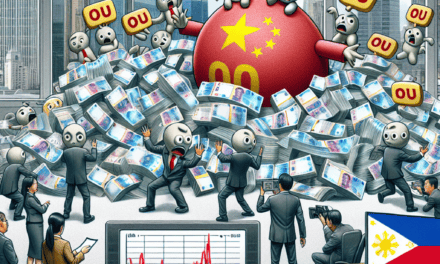“Goldman Sachs Cautions: Trump’s Market Surge May Face a Swift Sunset.”
Introduction
Goldman Sachs has issued a cautionary note regarding the sustainability of the stock market rally attributed to policies and expectations surrounding former President Donald Trump. The financial institution suggests that while the market has experienced significant gains, driven by optimism over tax reforms, deregulation, and infrastructure spending, these factors may not provide long-term support for continued growth. Analysts at Goldman Sachs highlight potential risks, including geopolitical tensions, policy implementation challenges, and economic fundamentals that could undermine the rally’s momentum. As investors navigate this complex landscape, the warning serves as a reminder of the inherent volatility and unpredictability of financial markets.
Analysis Of Trump’s Stock Market Rally: A Temporary Surge?
In recent months, the stock market has experienced a notable surge, largely attributed to the economic policies and rhetoric of former President Donald Trump. This rally has captured the attention of investors and analysts alike, sparking discussions about its sustainability and long-term implications. However, Goldman Sachs, a leading global investment banking firm, has issued a cautionary note, suggesting that this upward trend may be short-lived. As we delve into the intricacies of this market phenomenon, it is essential to consider the factors driving the rally and the potential risks that could undermine its longevity.
To begin with, the stock market rally under Trump’s influence can be attributed to several key factors. Primarily, the former president’s pro-business stance, characterized by tax cuts and deregulation, has fostered a favorable environment for corporate growth and profitability. These policies have, in turn, bolstered investor confidence, leading to increased market activity and rising stock prices. Additionally, Trump’s emphasis on infrastructure spending and job creation has further fueled optimism about economic expansion, contributing to the rally’s momentum.
Despite these positive indicators, Goldman Sachs has raised concerns about the sustainability of this market surge. One of the primary reasons for their caution is the potential for economic overheating. The rapid pace of growth, while initially beneficial, could lead to inflationary pressures that may necessitate intervention by the Federal Reserve. Should the central bank decide to raise interest rates to curb inflation, borrowing costs would increase, potentially dampening consumer spending and corporate investment. This scenario could, in turn, trigger a market correction, reversing some of the gains achieved during the rally.
Moreover, geopolitical uncertainties pose a significant risk to the stock market’s stability. Trump’s approach to international trade, characterized by protectionist measures and tariff impositions, has introduced a level of unpredictability that could disrupt global supply chains and trade relationships. Such disruptions may adversely affect multinational corporations, leading to volatility in stock prices. Furthermore, ongoing tensions with countries like China and Iran could exacerbate these risks, creating an environment of uncertainty that may deter investors.
In addition to these external factors, internal market dynamics also warrant consideration. The current rally has been driven, in part, by a concentration of gains in a few high-performing sectors, such as technology and finance. This uneven distribution of growth raises concerns about the market’s overall health and resilience. Should these sectors experience a downturn, the broader market could suffer disproportionately, amplifying the impact of any negative developments.
In light of these considerations, it is crucial for investors to approach the current stock market rally with a degree of caution. While the economic policies and initiatives associated with Trump’s tenure have undoubtedly contributed to the market’s recent performance, the potential for volatility and correction remains significant. By remaining vigilant and informed about the various factors at play, investors can better navigate the complexities of the market and make strategic decisions that align with their long-term financial goals.
In conclusion, while the stock market rally under Trump’s influence has generated considerable enthusiasm, it is essential to recognize the potential challenges that could undermine its sustainability. Goldman Sachs’ warning serves as a timely reminder of the need for careful analysis and prudent investment strategies in an ever-evolving economic landscape. As we continue to monitor developments, a balanced perspective will be key to understanding the true nature of this market phenomenon.
Goldman Sachs’ Perspective On The Sustainability Of Market Gains
Goldman Sachs has recently issued a cautionary note regarding the sustainability of the stock market rally that has been associated with former President Donald Trump’s economic policies. While the market has experienced significant gains, driven by optimism surrounding tax cuts, deregulation, and infrastructure spending, Goldman Sachs analysts suggest that these gains may not be as enduring as some investors hope. This perspective is rooted in a comprehensive analysis of both macroeconomic indicators and the inherent volatility of market sentiment.
To begin with, the initial surge in the stock market can be attributed to the anticipation of pro-business policies that were expected to stimulate economic growth. Investors were particularly buoyed by the promise of corporate tax cuts, which were seen as a catalyst for increased corporate profits and, consequently, higher stock valuations. However, Goldman Sachs warns that the effects of such fiscal policies may be temporary. The firm points out that while tax cuts can provide a short-term boost to corporate earnings, they do not necessarily translate into long-term economic growth. This is because the benefits of tax cuts may be offset by rising deficits and potential inflationary pressures, which could lead to higher interest rates and a tightening of monetary policy.
Moreover, Goldman Sachs highlights the potential risks associated with deregulation. While reducing regulatory burdens can enhance business efficiency and profitability, it also raises concerns about financial stability and environmental sustainability. The firm notes that excessive deregulation could lead to increased systemic risks, particularly in the financial sector, where past deregulation efforts have sometimes resulted in market excesses and subsequent crises. Therefore, while deregulation may contribute to short-term market gains, it could also sow the seeds of future instability.
In addition to these policy-related factors, Goldman Sachs emphasizes the importance of considering broader economic conditions. The global economic environment remains uncertain, with geopolitical tensions, trade disputes, and fluctuating commodity prices posing significant challenges. These external factors can have a profound impact on market dynamics, potentially undermining the positive effects of domestic policy measures. Furthermore, the firm points out that the U.S. economy is in a mature phase of the business cycle, characterized by low unemployment and moderate growth. In such a context, the scope for further acceleration in economic activity may be limited, which could constrain the potential for sustained market gains.
Transitioning to investor behavior, Goldman Sachs also draws attention to the role of market sentiment in driving stock prices. The firm cautions that investor optimism can be fickle, and markets are prone to overreacting to both positive and negative news. This inherent volatility means that any shift in sentiment, whether due to policy changes, economic data releases, or geopolitical events, could lead to sharp market corrections. As such, the current rally, while impressive, may be vulnerable to sudden reversals.
In conclusion, while the stock market rally associated with Trump’s policies has generated substantial gains, Goldman Sachs advises caution. The firm underscores the importance of a balanced perspective, taking into account both the potential benefits and risks of current economic policies. Investors are encouraged to remain vigilant and consider the broader economic landscape, as well as the inherent volatility of market sentiment, when making investment decisions. By doing so, they can better navigate the complexities of the market and make informed choices that align with their long-term financial goals.
Factors Contributing To The Potential Short-Lived Nature Of The Rally
Goldman Sachs has recently issued a cautionary note regarding the sustainability of the stock market rally attributed to former President Donald Trump. While the market has experienced significant gains, the investment bank suggests that several factors could contribute to the potential short-lived nature of this rally. Understanding these factors is crucial for investors seeking to navigate the complexities of the current economic landscape.
To begin with, one of the primary concerns highlighted by Goldman Sachs is the uncertainty surrounding fiscal policies. During Trump’s tenure, the administration implemented substantial tax cuts and deregulation measures, which initially spurred economic growth and investor confidence. However, the long-term effects of these policies remain uncertain, particularly as the political landscape continues to evolve. With changes in administration and potential shifts in policy direction, the market may face volatility as investors react to new fiscal strategies.
Moreover, the global economic environment plays a significant role in shaping the trajectory of the stock market. Trade tensions, particularly between the United States and China, have been a persistent source of uncertainty. While there have been periods of negotiation and temporary resolutions, the underlying issues remain unresolved. Any escalation in trade disputes could disrupt global supply chains and negatively impact corporate earnings, thereby dampening investor sentiment and potentially curtailing the rally.
In addition to geopolitical factors, domestic economic indicators also warrant attention. The U.S. economy, although resilient, is not immune to cyclical downturns. Indicators such as GDP growth, unemployment rates, and consumer confidence are critical in assessing the health of the economy. Any signs of economic slowdown or recessionary pressures could lead to a reevaluation of stock valuations, prompting a market correction. Furthermore, the Federal Reserve’s monetary policy decisions, particularly regarding interest rates, can significantly influence market dynamics. A shift towards tightening monetary policy could increase borrowing costs and reduce liquidity, thereby exerting downward pressure on stock prices.
Another aspect to consider is the valuation of stocks themselves. Goldman Sachs points out that the current market rally has led to elevated stock valuations, with some sectors experiencing particularly high price-to-earnings ratios. While investor optimism has driven these valuations, there is a risk that they may not be sustainable in the long term. If corporate earnings fail to meet expectations or if economic conditions deteriorate, a market correction could ensue as investors reassess the intrinsic value of their holdings.
Furthermore, technological advancements and innovation, while generally positive for economic growth, also introduce an element of unpredictability. The rapid pace of technological change can disrupt traditional industries and create winners and losers in the market. Companies that fail to adapt to new technologies may face declining revenues and profitability, impacting their stock performance. Conversely, those that successfully leverage innovation may experience significant gains, contributing to market volatility.
In conclusion, while the stock market rally associated with Trump’s policies has generated substantial gains, Goldman Sachs warns that several factors could contribute to its potential short-lived nature. Uncertainty surrounding fiscal policies, global economic conditions, domestic economic indicators, stock valuations, and technological advancements all play a role in shaping the market’s future trajectory. Investors must remain vigilant and consider these factors when making investment decisions, as the market’s current momentum may not be sustainable in the long term.
Historical Comparisons: Past Market Rallies And Their Durations
Goldman Sachs has recently issued a cautionary note regarding the sustainability of the stock market rally observed during Donald Trump’s presidency. This warning invites a closer examination of historical market rallies and their durations, providing a context for understanding the potential trajectory of the current market situation. Historically, stock market rallies have often been influenced by a combination of economic policies, investor sentiment, and external factors. By analyzing past market rallies, we can gain insights into the possible longevity of the current upward trend.
To begin with, it is essential to consider the market rally that occurred during the presidency of Ronald Reagan in the 1980s. Reagan’s economic policies, often referred to as “Reaganomics,” included significant tax cuts, deregulation, and increased military spending. These measures initially spurred economic growth and investor confidence, leading to a substantial market rally. However, this rally was not without its challenges, as it was followed by a severe recession in the early 1980s. The market eventually recovered, but the initial exuberance was tempered by economic realities, illustrating that policy-driven rallies can be subject to volatility.
Similarly, the dot-com bubble of the late 1990s serves as another example of a market rally that was ultimately short-lived. Fueled by rapid technological advancements and speculative investments in internet-based companies, the stock market experienced unprecedented growth. However, this rally was largely driven by investor speculation rather than solid economic fundamentals. When the bubble burst in the early 2000s, it led to a significant market downturn, highlighting the risks associated with rallies that lack a strong economic foundation.
In more recent history, the financial crisis of 2008 and the subsequent recovery provide further insights into market rally dynamics. The crisis led to a severe market downturn, but the implementation of aggressive monetary policies, such as quantitative easing, helped stabilize the economy and initiate a prolonged market rally. This recovery was characterized by a slow but steady increase in stock prices, supported by improving economic indicators and corporate earnings. However, it also underscored the importance of sustainable economic growth in maintaining a long-term market rally.
Turning to the present, the stock market rally during Trump’s presidency has been driven by a combination of tax cuts, deregulation, and a strong labor market. While these factors have contributed to investor optimism and market growth, Goldman Sachs warns that the rally may be short-lived. The firm points to potential risks such as geopolitical tensions, trade disputes, and the possibility of rising interest rates, which could dampen investor sentiment and lead to market volatility.
Moreover, the current rally has been characterized by significant stock buybacks and corporate earnings growth, which, while positive in the short term, may not be sustainable in the long run. As history has shown, rallies that rely heavily on such factors without addressing underlying economic challenges can be vulnerable to sudden reversals.
In conclusion, while the stock market rally during Trump’s presidency has been impressive, historical comparisons suggest that caution is warranted. Past market rallies have demonstrated that while economic policies and investor sentiment can drive significant growth, they are often subject to external pressures and economic realities. As such, investors should remain vigilant and consider the potential risks that could impact the longevity of the current market rally.
Investor Strategies Amidst Uncertain Market Conditions
In recent months, the stock market has experienced a notable surge, largely attributed to the economic policies and optimistic rhetoric of former President Donald Trump. However, Goldman Sachs has issued a cautionary note, suggesting that this rally may not be sustainable in the long term. Investors, therefore, must navigate these uncertain market conditions with a strategic approach that balances potential gains with inherent risks. As the market continues to react to political and economic developments, it is crucial for investors to remain vigilant and adaptable.
Goldman Sachs’ warning is rooted in several key factors that could undermine the current market rally. Firstly, the global economic landscape remains fraught with challenges, including geopolitical tensions, supply chain disruptions, and inflationary pressures. These issues have the potential to destabilize markets and erode investor confidence. Furthermore, the Federal Reserve’s monetary policy decisions, particularly regarding interest rates, could significantly impact market dynamics. As the Fed grapples with balancing economic growth and inflation control, any shifts in policy could lead to increased market volatility.
In light of these uncertainties, investors are advised to adopt a diversified investment strategy. Diversification can help mitigate risks by spreading investments across various asset classes, sectors, and geographic regions. This approach not only reduces exposure to any single market downturn but also allows investors to capitalize on growth opportunities in different areas. Additionally, maintaining a balanced portfolio that includes a mix of equities, bonds, and alternative investments can provide stability and potential for returns, even amidst market fluctuations.
Moreover, investors should consider the importance of staying informed and agile in their decision-making processes. Keeping abreast of economic indicators, corporate earnings reports, and geopolitical developments can provide valuable insights into market trends and potential risks. By staying informed, investors can make timely adjustments to their portfolios, ensuring they are well-positioned to respond to changing market conditions.
Another critical aspect of navigating uncertain markets is understanding one’s risk tolerance and investment objectives. Investors should assess their financial goals, time horizons, and risk appetite to determine the most appropriate investment strategy. For some, this may mean adopting a more conservative approach, focusing on capital preservation and steady income generation. For others, it may involve taking on higher risk in pursuit of greater returns. Regardless of individual preferences, having a clear understanding of one’s investment objectives can guide decision-making and help maintain focus during periods of market turbulence.
In addition to these strategies, investors should also be mindful of the potential impact of regulatory changes and fiscal policies on the market. As governments worldwide continue to implement measures to address economic challenges, these policies can have far-reaching effects on various industries and sectors. Staying informed about potential regulatory shifts can help investors anticipate changes and adjust their strategies accordingly.
In conclusion, while the current stock market rally may present enticing opportunities, Goldman Sachs’ warning serves as a reminder of the inherent risks and uncertainties that persist. By adopting a diversified investment strategy, staying informed, understanding risk tolerance, and being mindful of regulatory changes, investors can better navigate these uncertain market conditions. Ultimately, a proactive and informed approach will be essential for achieving long-term investment success amidst the ever-evolving economic landscape.
Economic Indicators That Could Impact The Market’s Trajectory
Goldman Sachs has recently issued a cautionary note regarding the sustainability of the stock market rally that has been associated with former President Donald Trump. While the market has experienced significant gains, driven by optimism surrounding tax cuts, deregulation, and economic growth, there are several economic indicators that suggest this upward trajectory may not be sustainable in the long term. Understanding these indicators is crucial for investors and policymakers alike as they navigate the complexities of the financial landscape.
To begin with, one of the primary concerns highlighted by Goldman Sachs is the potential for rising interest rates. The Federal Reserve, in its efforts to curb inflation and maintain economic stability, may opt to increase interest rates. Such a move could have a cooling effect on the stock market, as higher borrowing costs can lead to reduced consumer spending and corporate investment. Consequently, this could dampen the enthusiasm that has fueled the market’s recent gains. Moreover, higher interest rates often lead to a stronger dollar, which can negatively impact U.S. exports by making them more expensive for foreign buyers.
In addition to interest rates, another critical factor to consider is the state of global trade. The Trump administration’s approach to trade, characterized by tariffs and renegotiated trade agreements, has introduced a level of uncertainty that could weigh on market performance. While some industries may benefit from protectionist measures, others could suffer from retaliatory tariffs and disrupted supply chains. This uncertainty can lead to volatility in the stock market, as investors react to the shifting landscape of international trade relations.
Furthermore, corporate earnings, a key driver of stock market performance, may face headwinds in the coming months. While tax cuts have provided a temporary boost to corporate profits, there are concerns that this effect may wane over time. Companies may struggle to maintain their earnings growth in the face of rising labor costs, supply chain disruptions, and increased competition. As a result, investors may need to temper their expectations for future earnings growth, which could lead to a reassessment of stock valuations.
Additionally, geopolitical tensions remain a persistent risk factor that could impact the market’s trajectory. Conflicts in regions such as the Middle East, as well as tensions with major economic powers like China and Russia, have the potential to create instability in global markets. Investors often react to geopolitical events with caution, leading to increased market volatility and potential sell-offs.
Moreover, the broader economic environment must also be taken into account. While the U.S. economy has shown resilience, there are signs that growth may be slowing. Factors such as declining consumer confidence, slowing job growth, and potential fiscal challenges could all contribute to a more subdued economic outlook. A slowing economy can have a direct impact on corporate profits and, by extension, stock market performance.
In conclusion, while the stock market rally associated with Trump’s policies has been impressive, Goldman Sachs warns that several economic indicators could pose challenges to its sustainability. Rising interest rates, global trade uncertainties, potential earnings headwinds, geopolitical tensions, and a slowing economy all represent potential obstacles that could impact the market’s trajectory. Investors and policymakers must remain vigilant and consider these factors as they make decisions in an ever-evolving economic landscape.
The Role Of Political Events In Shaping Market Trends
Goldman Sachs, a leading global investment banking, securities, and investment management firm, has recently issued a cautionary note regarding the sustainability of the stock market rally attributed to former President Donald Trump. This warning highlights the intricate relationship between political events and market trends, underscoring the need for investors to remain vigilant and informed. Political events have long been recognized as significant influencers of market behavior, often causing fluctuations that can either bolster or undermine investor confidence. The Trump administration’s policies, characterized by tax cuts, deregulation, and a focus on domestic economic growth, initially spurred optimism among investors, leading to a notable surge in stock market indices. However, Goldman Sachs’ analysis suggests that the longevity of this rally may be in question.
One of the primary reasons for this skepticism is the inherent volatility associated with political events. While the initial market response to Trump’s policies was overwhelmingly positive, the long-term effects are less predictable. Political decisions can lead to shifts in economic fundamentals, such as interest rates, inflation, and employment levels, which in turn influence market performance. For instance, while tax cuts may provide a short-term boost to corporate profits and stock prices, they can also lead to increased fiscal deficits, potentially resulting in higher interest rates that could dampen economic growth.
Moreover, the global nature of financial markets means that domestic political events can have far-reaching implications. Trade policies, in particular, have been a focal point of the Trump administration, with tariffs and trade negotiations impacting international relations and economic stability. These actions can create uncertainty, prompting investors to reassess their risk exposure and potentially leading to market volatility. Goldman Sachs’ warning serves as a reminder that while political events can drive market trends, they can also introduce elements of unpredictability that investors must navigate.
In addition to the direct impact of political decisions, market sentiment plays a crucial role in shaping trends. Investor psychology is often influenced by perceptions of political stability and policy direction. During periods of political uncertainty, such as elections or major policy shifts, market participants may react with caution, leading to increased volatility. Conversely, a stable political environment can foster confidence, encouraging investment and supporting market growth. However, this sentiment-driven aspect of market behavior can be fleeting, as new developments or unforeseen events can quickly alter investor perceptions.
Furthermore, the interconnectedness of global economies means that political events in one country can have ripple effects across the world. The Trump administration’s approach to international relations, including its stance on trade agreements and geopolitical issues, has had implications for global markets. Investors must consider not only domestic political developments but also their potential impact on international economic dynamics. This complexity underscores the importance of a comprehensive understanding of the interplay between politics and markets.
In conclusion, while political events undeniably shape market trends, their influence is multifaceted and often unpredictable. Goldman Sachs’ warning about the potential short-lived nature of Trump’s stock market rally highlights the need for investors to remain cautious and informed. By recognizing the intricate relationship between political decisions and market behavior, investors can better navigate the challenges and opportunities presented by an ever-evolving economic landscape. As political events continue to unfold, their impact on market trends will remain a critical consideration for investors seeking to make informed decisions in an increasingly complex world.
Q&A
1. **What is the main warning from Goldman Sachs regarding Trump’s stock market rally?**
Goldman Sachs warns that the stock market rally following Trump’s election could be short-lived due to potential policy uncertainties and economic challenges.
2. **What factors does Goldman Sachs cite as potential risks to the rally?**
The bank cites policy uncertainties, such as tax reforms, trade policies, and regulatory changes, as potential risks that could impact the sustainability of the rally.
3. **How does Goldman Sachs view the impact of Trump’s proposed tax reforms?**
While tax reforms could initially boost the market, Goldman Sachs is cautious about their long-term impact, especially if they lead to increased deficits or fail to pass through Congress.
4. **What is Goldman Sachs’ stance on Trump’s trade policies?**
Goldman Sachs expresses concern that protectionist trade policies could lead to trade wars, negatively affecting global trade and economic growth.
5. **Does Goldman Sachs believe the rally is based on solid economic fundamentals?**
Goldman Sachs suggests that the rally may not be fully supported by economic fundamentals and could be driven by investor optimism and speculation.
6. **What is the potential impact of regulatory changes according to Goldman Sachs?**
While deregulation could benefit certain sectors, Goldman Sachs warns that it might also lead to increased risks and instability in the financial system.
7. **How does Goldman Sachs recommend investors approach the market given their warning?**
Goldman Sachs advises investors to remain cautious, diversify their portfolios, and be prepared for potential volatility in the market.
Conclusion
Goldman Sachs has issued a warning that the stock market rally attributed to policies and expectations surrounding former President Donald Trump may be short-lived. The investment bank suggests that while initial market enthusiasm might drive stock prices higher, underlying economic fundamentals and potential policy challenges could limit the sustainability of this rally. Factors such as geopolitical risks, trade tensions, and fiscal policy uncertainties could undermine investor confidence and lead to market volatility. Therefore, while the rally may provide short-term gains, investors should remain cautious and consider the potential for a market correction.





